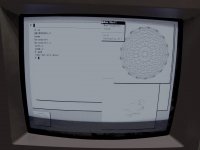snuci
Veteran Member
I've had a bit of an adventure lately and I'm not done yet. After acquiring a Commodore 900 last year I finally had the time to look into it. Being that it was originally from Germany, the power supplies were supposed to be 240v but the previous owner did some work on them and thought the computer power supply was 120v but the monitor was 240v. As it turns out, the PC power supply had issues that were not easily diagnosed (it blew fuses) so I found a replacement in the Commodore PC10-II which worked. I had no idea until someone pointed that out to me. I then had issues with the monitor power supply so I found a replacement with the same specs (24VDC at 2.7A) and that worked like a charm.
The ongoing issue has been the Miniscribe 3425 20MB MFM hard drive. It had a terrible squeak on start up and shut down and the stepper motor was locked up so I freed up the stepper motor and lubed both motors. The issue I have at present is that I am trying to archive off the data as it contains several demos and what appears to be the Coherent 0.7.3 source code that the C900 runs off of but the hard drive spins down after about 40 minutes or so. The drive light stays solid. The last time today it spun up again but the light stayed solid and that was it. I had to power it down.
I ordered and MFM Emulator board from David Gesswein and I am hoping I can image the hard drive and reimage another Miniscribe 3425. I am unsure if it will be able to emulate the hard drive exactly as the Western Digital based controller (WD1003-CMD) is custom made for this computer and I believe it uses SASI commands to talk the MFM drive. Oh and to top it off, you cannot format a hard drive because there is no utility to do it. There is a ROM monitor program that I think may do it but I don't have that version.
The floppy drive is working but it is a quad-density drive that might be talking GCR. I believe it's 96tpi but some have said it may be 100tpi. Long story short, nothing but a C900 can read those disks so even a backup won't help.
So, suffice is to say, it's a project. It has Kermit at 9600 bps but by the time I can send stuff to a PC, the hard drive spins down.
Regardless of the issues, I have been able to record some "hi-res" graphic demos that were used in the 1985 Hannover Fair CeBit in Germany. You can see some pictures and the videos are link at http://vintagecomputer.ca/commodore-900/
While I am aware that I need to get the data off of this drive ASAP, I haven't found why the drive spins down with no errors and a solid drive light. Has anyone else seen this? I thought it might be heat related but I ran this with and without the computer cover and it still lasts about the same amount of time. The MFM emulator will come soon but I was just curious if anyone has seen this and has been able to fix it.
The ongoing issue has been the Miniscribe 3425 20MB MFM hard drive. It had a terrible squeak on start up and shut down and the stepper motor was locked up so I freed up the stepper motor and lubed both motors. The issue I have at present is that I am trying to archive off the data as it contains several demos and what appears to be the Coherent 0.7.3 source code that the C900 runs off of but the hard drive spins down after about 40 minutes or so. The drive light stays solid. The last time today it spun up again but the light stayed solid and that was it. I had to power it down.
I ordered and MFM Emulator board from David Gesswein and I am hoping I can image the hard drive and reimage another Miniscribe 3425. I am unsure if it will be able to emulate the hard drive exactly as the Western Digital based controller (WD1003-CMD) is custom made for this computer and I believe it uses SASI commands to talk the MFM drive. Oh and to top it off, you cannot format a hard drive because there is no utility to do it. There is a ROM monitor program that I think may do it but I don't have that version.
The floppy drive is working but it is a quad-density drive that might be talking GCR. I believe it's 96tpi but some have said it may be 100tpi. Long story short, nothing but a C900 can read those disks so even a backup won't help.
So, suffice is to say, it's a project. It has Kermit at 9600 bps but by the time I can send stuff to a PC, the hard drive spins down.
Regardless of the issues, I have been able to record some "hi-res" graphic demos that were used in the 1985 Hannover Fair CeBit in Germany. You can see some pictures and the videos are link at http://vintagecomputer.ca/commodore-900/
While I am aware that I need to get the data off of this drive ASAP, I haven't found why the drive spins down with no errors and a solid drive light. Has anyone else seen this? I thought it might be heat related but I ran this with and without the computer cover and it still lasts about the same amount of time. The MFM emulator will come soon but I was just curious if anyone has seen this and has been able to fix it.

